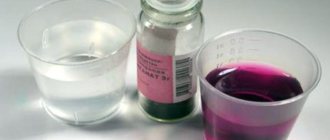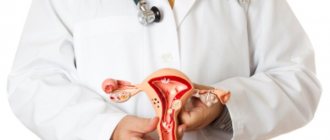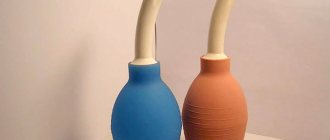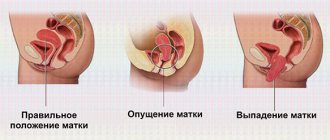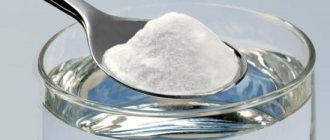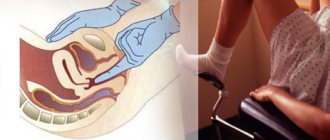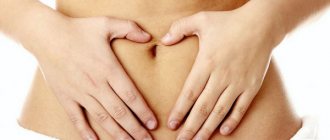Symptoms of uterine prolapse
Nagging pain in the lower abdomen, urinary disorders (complete or partial urinary incontinence when coughing, physical activity), constipation are early symptoms of the first stage of uterine prolapse. In later stages, symptoms are obvious
Massage
The most effective folk remedy for treating uterine prolapse is massage 1. Get on your knees, rest your elbows on the floor, someone comes up from behind and shakes your buttocks 2. On an empty stomach before going to bed, cleanse the intestines, lie on your back, place a tight pillow under your pelvis, bend your legs in knees. Place both hands on the right side of your abdomen just below your navel. Using your fingers to press down slightly, gently pull up.
It will hurt. Mentally repeat the spell “Mother, stand up in the old way, just like your father and mother did.” Pull up until the pain is felt. After this, forcefully bring your arms in front of your chest, raise your straight legs 10-15 cm from the floor for 60 seconds. Do the same with the central and left part of the abdomen. Do it within a week. Then vacuum therapy (contraindications: age over 60 years)
3. Vacuum therapy. Take 1/2 of a raw potato, stick it with 10 matches, place it on your navel, and light all the matches. Cover them with a 1-1.5 liter jar or pot with a narrow neck, greasing the edges with oil. After placing the jar, lie down for 5 minutes. with half-bent legs, getting used to the pain, then stand in a knee-elbow position (the can hangs). Maintain the position for 10-15 minutes. Remove the can. If a bruise forms, the procedure was successful. Repeat the procedure 1-2 days after the bruise disappears. Course 10-13 sessions.
Massage and exercise
Massage for prolapsed uterus
Vacuum massage with a regular jar is considered one of the most ancient therapeutic methods. Place the jar (volume 0.5 l) on the bed, lie on it so that the navel is directly in its center. There may be severe discomfort, but you need to lie there for at least 3-5 minutes. Then lie down (without kneeling or legs) on your right side and lie there for another 10-15 minutes. Then turn over onto your back, tie your stomach well with a suitable cloth and stand up. If everything was done correctly, there will be no pain at all when standing.
Take a lying position, bend your knees, and massage the uterine area so that the uterus seems to rise up. Next you need to take a potato (medium), cut it in half, insert 5 matches into one part of the potato (the heads should look up). Place it on your stomach, light matches and cover the entire “structure” with a half-liter jar, the edges of which should be greased with oil. Lie down for five minutes, then remove the jar in the same way as medical cups are removed (that is, lightly pressing the skin so that air gets under the jar). After the procedure, you need to lie down for about twenty minutes, raising your legs above your head, then tie up your stomach and you can get up. This treatment must be done on an empty stomach for three days in a row, while refraining from lifting heavy objects.
Kegel exercise is an excellent prevention of uterine prolapse, so it should be performed by older women and those who are prone to this disease. It consists of regularly tensing and relaxing the muscles of the vagina and anus. The feeling should be as if the woman wants to hold in urine. You need to do the exercise for at least 25 rubles. in a day.
Kegel exercise
If you have a tendency to prolapse of the uterus or its first symptoms, you need to take the so-called cat pose every morning, without getting out of bed. To do this, stand on your elbows and knees, arch your back, lower your stomach as low as possible and raise your buttocks as much as possible. You need to stay in this position for at least 15 minutes, then 5 minutes. rest on your back. The exercise should be done for 20 days.
Cat pose
When you wake up in the morning, roll over onto your back, stretch your legs and do a special massage. You need to clench one hand into a fist, and, in turn, squeeze it with the palm of your other hand. With your hands folded in this way, move them in a circular motion over your stomach, pressing well, first clockwise and then counterclockwise. It’s better to start with 2-3 movements, gradually increasing their number to 20.
When the uterus prolapses, it is recommended to do a set of simple exercises daily: “birch tree”, “scissors”, “bicycle”, raising the pelvis from a lying position, and also ride a bicycle.
Birch exercise
Video - Prolapse of the uterus and vagina. Treatment
Treatment of uterine prolapse with folk remedies
In folk methods of treatment, herbs and herbal preparations are widely used, which alleviate the patient’s condition and increase the tone of the uterine muscles.
Melissa
2 tbsp. l. lemon balm pour 2 tbsp. boiling water overnight in a thermos. Take 2/3 tbsp. 1 hour before meals.
Herbal infusion
Coltsfoot – 100 g, oregano – 75 g, lemon balm – 75 g. 2 tbsp. l. Brew the mixture in a thermos 2 tbsp. boiling water Take 2/3 tbsp. 1 hour before meals.
Tincture of elecampane
For 0.5 liters of vodka put 1 tbsp. l. with the top of an elecampane. Leave for 10 days in a dark place. Drink 1 tbsp once a day in the morning on an empty stomach. l.
A mixture of eggshells and lemons is the most famous folk remedy for treating prolapse and uterine prolapse.
You need to crush the dried shells of 5 eggs in a mortar, mix this flour with 9 finely chopped lemons. Leave for 4 days, add 0.5 liters of vodka, leave for another three days. Stir, strain, squeeze. Take 50 g in the morning and evening until the mixture runs out. The course is carried out three times with monthly breaks between courses.
Folk remedies for inflammation of the uterus
Every woman should be examined by a gynecologist twice a year. After all, this is the only way to detect diseases in time and cure them. It is precisely because of untimely treatment of diseases of the female reproductive system that there is a risk of infertility. But it is also important to immediately consult a doctor at the first symptoms of illness.
Most women are familiar with painful sensations in the lower abdomen during menstruation. Some women may experience pain in the first few days, while others may experience pain throughout the week. And for some reason everyone is accustomed to considering this the norm, and almost no one seeks the help of a specialist.
Treatment of uterine inflammation with folk remedies
You should know that pain during menstruation can be a signal of the presence of an inflammatory process that requires immediate treatment.
Endometritis is an inflammation of the endometrium (the inner mucous layer of the uterus) one of the most common diseases, which, if left untreated, can lead to very disastrous consequences. Endometritis can be acute or chronic. Acute endometritis refers to damage to the basal layer of the endometrium.
Acute inflammation of the uterus
What are the main causes of acute endometritis? There are actually a lot of reasons, but the most common of them are:
- consequences of childbirth (especially if the birth was difficult);
- abortions with curettage (mechanical damage to the endometrium occurs);
- incorrectly performed caesarean section;
- examination using dilators and colposcope;
- sexual intercourse during menstruation;
- long-term use of an intrauterine device;
- the presence of uterine diseases of an infectious nature.
Symptoms of acute endometritis
The first symptoms usually appear on the third or fourth day after infection. Body temperature rises significantly and chills are noted. A characteristic sign of inflammation of the uterus is pain in the lower abdomen, which can radiate to the groin or sacrum.
The discharge becomes profuse serous-purulent, with a characteristic fetid, putrid odor. Bloody discharge indicates a delay in the regeneration of the mucous membrane. In some cases, the discharge may be bloody (if there is a remaining fertilized egg). With inflammation of the uterus caused by gonorrhea, only bleeding is noted.
In most cases, endometritis is accompanied by general malaise and rapid heartbeat.
Another sign of the presence of an inflammatory process is pain during a gynecological examination.
Chronic endometritis: causes
As a rule, it develops as a result of untreated acute processes, or those whose treatment was incorrect. Inflammation of the uterus, which was not diagnosed in a timely manner, is another important reason for the development of the inflammatory process.
Chronic endometritis is quite difficult to recognize. And this is explained, first of all, by a blurry and nonspecific clinical picture. The main manifestations of chronic endometritis include:
- menstrual irregularities;
- the appearance of painful sensations in the lower abdomen;
- pulling, aching pain in the lower back;
- slight increase in temperature;
- the presence of serous or serous-purulent discharge;
- bleeding.
It is very important to seek the help of a specialist in time. In case of acute endometritis, hospitalization is indicated.
Traditional medicine recipes
As already mentioned, treatment for this disease must be timely. Remember that diseases of the female reproductive system are not something to joke about, especially if you plan to experience all the delights of motherhood.
In addition to the therapy prescribed by the doctor, traditional medicine is also effective. They will not only help eliminate inflammation and pain, they will help completely cure the disease.
But it is not recommended to replace traditional medicine with traditional medicine. A positive effect can only be achieved if the treatment is comprehensive, which involves taking medications and herbal remedies. In addition, before using any product, be sure to consult your doctor.
Traditional medicine will ideally complement the main treatment and contribute to a speedy recovery.
Healing infusions and decoctions
1. To prepare the product you will need: pine buds, lavender, marshmallow root, sweet clover, nettle, dried herb, wormwood herb, blueberry leaves and leuzea herb.
All ingredients must be mixed thoroughly. A couple of spoons of raw materials should be placed in a thermos and poured with two glasses of boiled water and left to infuse for about ten hours, then strain. Take a third of a glass four times a day. The duration of taking the infusion is two months.
2. Take calendula, angelica, bearberry, coltsfoot, bergenia, chicory, thyme and kidneyweed herb. Grind all ingredients thoroughly and mix. Pour boiling water over two tablespoons of the raw material, then leave to steep for ten hours, then strain. Drink a third of a glass two to three times a day. Treatment with this infusion is necessary for at least two months.
3. To prepare the next infusion, take: mantle leaves, rhodiola, viburnum bark, chamomile, shepherd’s purse, thyme, motherwort, youngwort and mint. Grind all the ingredients and add boiled water. Let the product sit overnight. Drink a third of a glass several times a day with the addition of one spoon of honey. The duration of the course is two months.
4. Chop the fern leaves and add boiled water. Then put on low heat and boil in a water bath for twenty minutes, cool. You need to drink the medicine two to three times a day, 1/4 cup. The duration of such treatment is three weeks.
Treatment of uterine inflammation with fruits
Take an orange and a lemon, wash them under running water, dry them, and then grind them in a blender. Add half a spoonful of sugar and a few drops of onion tincture to the resulting fruit mixture. Mix everything well. The finished medicine must be taken twice a day, one spoonful. The duration of treatment is three weeks.
Preparation of St. John's wort decoction
A spoonful of St. John's wort must be filled with 200 ml of boiled water and boiled over low heat for half an hour, then strain. The medication should be taken three times a day, a quarter glass. The duration of the course is a week. You should not take this medicine without your doctor's knowledge, as it can lead to exacerbation of chronic ailments.
Infusions for douching
1. To prepare the product you will need immortelle leaves and flowers, elderberry flowers and oak bark. All ingredients must be thoroughly chopped and mixed. Pour five tablespoons of raw material into a liter of boiled water and leave to steep for about an hour.
Use this douche in the morning and evening. The duration of the course is no more than five days.
2. Bergenia decoction for douching. To prepare the product, take the rhizomes of the plant and chop thoroughly. After this, pour boiling water and leave to simmer over low heat for half an hour. Then strain and cool. Use for daily douching. The duration of the course is a week.
3. Bedstraw and peony will eliminate the disease. To prepare the decoction you will need dried bedstraw herb. Take three tablespoons of the crushed plant and pour two glasses of boiling water.
The product must be infused for at least two hours. Drink a quarter glass three times a day for two weeks.
4. Peony infusion also has excellent healing properties. Take the dry roots of the plant and grind them, then pour boiling water over them and leave to steep for thirty minutes. Take one spoon before each meal. The course of treatment is three weeks.
Several recommendations to prevent the development of the disease
- Visit your gynecologist twice a year.
- Don’t put off treating women’s diseases until later.
- If you experience pain or discharge (with an odor or blood), go to a specialist immediately.
- Dress according to the weather, take care of your women's health.
data-ad-format=”auto”>
Source: https://NarodnymiSredstvami.ru/vospalenie-matki-i-ego-lechenie-narodnyimi-sredstvami/
Uterine prolapse - exercises
Folk remedies for the treatment of uterine prolapse and uterine prolapse must be supplemented with therapeutic exercises. Gymnastics is the main method of treating this disease. The main thing here is systematicity and perseverance. The following exercises must be performed: 1. In the morning after waking up, stand on all fours for 10 minutes. 2. Get on your knees and place your hands on the floor. Bend over, trying to touch the floor with your chest 20-40 times. After 3 months of daily exercise, the organs should return to the right place. 3. Do all kinds of exercises for the press: raising the legs from a lying position, raising the torso from a lying position, “bicycle”, “scissors”, shoulder blade stand – “birch”, raising the pelvis, resting your feet and shoulders on the floor. 4. Squeeze the muscles of the perineum as often as possible
How to treat uterine prolapse - healthy lifestyle recipes
Folk treatment with infusion of fume grass
2 tsp. dry herbs, pour 2 cups of cool boiled water, leave for 8 hours. Drink half a glass three times a day, half an hour before meals. This herb improves the tone of the uterine muscles and is an effective folk remedy for uterine prolapse. (HLS 2011, No. 21, p. 27).
Exercises for uterine prolapse
This is a very good recipe for lifting the uterus, intestines, and stomach. You only need to do two exercises, then the body will recover on its own.
1. In the evening before going to bed, lie on your back, relax, bend your knees. Use your fingers to walk along the lower abdomen 3-5 times, lifting it slightly. The first few days will hurt a little, but then the pain will go away. 2. In the morning, without getting out of bed, roll over onto your stomach, kneel down and lean on your elbows. Lower your belly as low as possible and raise your hips as high as possible. Stand like this for 15 minutes. Then lie on your back and rest for 5 minutes. These exercises for uterine prolapse should be done for 20 days, but the woman did them for a whole month, because she had severe uterine prolapse. As a result, her constipation stopped, her periods improved, and her body started working normally. After this, she was able to give birth to two children. (HLS 2011, No. 21, pp. 31-32).
Traditional recipes for the treatment of uterine prolapse
Uterine prolapse occurs due to a number of factors that cause loss of tone in the muscles and ligaments designed to hold the organ in a fixed position. The causes of such changes in a woman’s body include hormonal imbalances, excessive physical activity, congenital pathologies in the pelvic area, and damage to the organs of the female reproductive system as a result of childbirth. Clinical manifestations of the pathology distinguish 4 stages of deterioration from minor symptoms characterizing the disease to the stage at which uterine prolapse becomes possible.
Important! With the exception of surgical intervention used in the later stages of the disease, improvement of the patient's condition until complete recovery is possible by performing a set of exercises, wearing a bandage or other prescribed loads, attending gynecological massage courses, and using traditional methods of therapy.
- To prevent uterine prolapse, it is necessary to dry and crush the shells of 5 chicken eggs into small crumbs. After this, 9 lemons are crushed to a homogeneous mushy state and the mass is mixed with the shells. After 4 days, 0.5 liters of vodka are added to the preparation and infused for 3 days. The finished drug is consumed after filtering twice a day, 25 ml during the course of treatment. The therapy cycle includes 3 courses, with a break between them of 1 month.
- A decoction based on dill seeds is characterized by a high therapeutic effect. To prepare it, you need to mix 1 teaspoon each of St. John's wort, chamomile, dill and chicory seeds, then pour the prepared ingredients into a thermos and pour 300 ml of boiling water. After infusing the decoction for 12 hours and filtering it, the entire prepared volume is consumed in small equal portions throughout the day. The therapeutic course is 3 months, but after 21 days of use, you must take a break for 14 days.
- Treatment of uterine prolapse at home can be done using plantain infusion. To prepare the medicine, you need to pour 50g of dried leaves of the plant with a liter of boiling water, then add 1 tablespoon of celery seeds to the resulting mixture and leave for 40 minutes, covered with a tight lid. The resulting solution is filtered, mixed with 100 g of honey and stirred until the latter is completely dissolved. The course of therapy is 1 month, during which it is necessary to take ¼ of a glass half an hour before the first meal.
Other methods for treating uterine prolapse at home
When the first symptoms of pathology appear, it is necessary to begin therapy using one of the methods agreed upon with the attending physician:
- Performing exercises allows you to eliminate the disorder within a short period of time with minimal pain for the patient. One of the exercises is that a woman, being in a standing position, begins to raise each of her legs in turn until she reaches 90° to the horizontal surface of the floor. This procedure is repeated 10 times for each leg.
- To perform another exercise, the woman is in a position on all fours, after which she simultaneously raises one of the legs and the opposite arm, repeating the procedure 5 times for each side.
- Being in the previous position, the woman lowers her head during the inhalation phase, while at the same time retracting the muscles of the anus and perineum. The procedure is performed as many times as possible, excluding the occurrence of pain, the minimum number of repetitions is 10 times.
- The use of a bandage is practiced in the early stages of the disease and as a preventive measure, used, for example, after a difficult childbirth. Timely wearing of a bandage and other structures significantly reduces the likelihood of developing prolapse to the stage of uterine prolapse.
- One of the most effective methods for preventing the development of pathology and excluding surgical intervention are Kegel exercises, based on training the muscles of the vagina and perineum. To perform it, you need to tense and relax the muscles in the perineal area for half a minute, gradually increasing the duration of exposure to 1 minute.
Note! The procedure is performed several times a day, several exercises per session, and in addition to the prevention of female pathologies, it helps to improve a woman’s sex life.
- To eliminate uterine prolapse, the application of compresses can be used, for the preparation of which it is necessary to mix 2 teaspoons of centaury, lemon balm leaves, and dead nettle flowers, after which 1 liter of boiling water is poured into the herbal mixture. After infusing for several hours, the solution is filtered, the resulting decoction is taken three times a day in a glass for 14 days. The remaining cake, in a warm state, is placed on gauze and placed in the abdominal area and left for an hour.
Treatment of uterine inflammation
Therapy with folk remedies is used as a complement to medications used to treat inflammation of the uterus. The use of the described recipes allows you to relieve pain symptoms and helps speed up the healing process. Among the most popular recipes, we should highlight:
- A decoction based on flaxseeds, for the preparation of which 1 cup of seeds is ground in a coffee grinder, after which 1 liter of hot water is added to the container. The resulting composition is brought to a boil and kept on fire for another 10 minutes, after which it is cooled, filtered and mixed with 4-5 tablespoons of natural linden honey. The solution is infused under the lid for 24 hours, after which the vaginal area is douched at least several times a day.
- A decoction for douching based on St. John's wort is also characterized by high efficiency. The recipe for this medicine includes mixing 100 g of the plant part of St. John's wort with 1 liter of boiling water, bringing to a boil and keeping on fire for 5 minutes. After cooling and straining, douching is carried out twice a day; before use, the product is slightly warmed up.
- Tea from viburnum flowers, for the preparation of which you need to pour 1 tablespoon of dried flowers with a glass of boiling water. After cooling, the tea is filtered and 1 teaspoon of honey is added to it. The dosage of the product includes taking it three times a day, half a glass per session.
- The use of clover infusion helps stop the inflammatory process and relieve pain symptoms. To prepare it, you need to add 700 ml of boiling water to 100 g of the plant, then leave to infuse for 24 hours. The resulting medicine is taken 1 glass before meals, four times a day, after mixing 1 teaspoon of honey in the infusion.
In addition to the methods listed above, when diagnosing inflammatory processes in the uterine area, baths using a decoction of bay leaves can be used. The decoction is prepared by mixing 100 grams of bay leaf with 1 liter of boiling water and then boiling for 15 minutes.
Benefits of therapy at home
Despite the great popularity and prevalence of traditional methods of treating disorders of the uterus, home treatment has a number of advantages, including:
- Significant reduction of pain symptoms, improvement of condition until complete recovery.
- The possibility of quick and painless resorption of benign formations without the use of synthetic drugs, when pathologies are detected in the uterus that are in the initial stages of development.
- Reducing the amount of uterine bleeding is only true if the drugs are chosen correctly, since some of them have the opposite effect.
- Normalization of hormonal levels occurs due to increased immunity and strengthened muscle tone, for example, when performing a complex of physical therapy.
- Stopping the growth of a benign tumor, stopping its development and gradual destruction of tissues with pathology.
- Normalization of blood circulation in the pelvic organs, since it is known that a significant part of the pathologies of the reproductive system is associated with stagnation of biological fluids in the body.
- Elimination of inflammatory processes when using medications that have antiseptic, antiviral and antibacterial effects.
These effects make it possible to use uterine therapy at home as an independent method of treatment or as part of a comprehensive course.
Symptoms and treatment with folk remedies for uterine prolapse
Uterine prolapse is a disease that is more often diagnosed in women past reproductive age. In the initial stages of the pathology, the symptoms are not obvious. Often the patient notices signs of the disease too late, which can lead to irreparable complications.
Treatment of uterine displacement with folk remedies is permissible only in the early stages, when there is no threat of organ prolapse.
Description of pathological displacement
In a normal anatomical position, the uterus is localized:
- at equal distances from the walls of the pelvis;
- in front of the rectum and behind the bladder;
- with a partial slope forward towards the bladder.
Any imbalance in the position of the uterus and nearby organs causes a change in normal functioning. Such disorders provoke uterine prolapse, which is more often diagnosed in women during menopause. However, girls of childbearing age are also not immune from this disease. In medical terminology, the condition of prolapse is called prolapse.
Uterine prolapse is a gradual decline of the organ relative to its physiological location. This occurs due to weakening of the ligaments and muscles that keep the uterus in its normal position. At the initial stage, uterine displacement occurs without pronounced symptoms; in advanced cases, prolapse of the uterus is recorded.
There are four stages of uterine prolapse:
- First. Characterized by asymptomatic changes in the position of the organ.
- Second. Uterine prolapse is detected when a woman pushes.
- Third. The cervix and part of the uterus descend into the vagina.
- Fourth. Complete loss of the organ is observed.
The initial stages of the disease are asymptomatic, but distinctive signs appear in the later stages. Common symptoms include:
- heavy menstrual flow;
- cycle disorders;
- discomfort, unpleasant sensations in the abdomen and vagina;
- pain in the lower abdomen;
- frequent urination, sometimes involuntary when the walls of the uterus prolapse;
- constipation;
- sensation of a foreign object in the vaginal area;
- unnatural sensations during sexual intercourse.
Often, many representatives of the fair sex endure unpleasant symptoms and manifestations of pathology. Most people turn to a gynecologist only when they independently identify the disease: when part of the uterus falls out of the vagina. This part may be pale pink with ulcers included.
Such an irresponsible attitude is unacceptable, because with gradual displacement the risk of infection increases.
Uterine prolapse can begin at a young age, gradually progressing. If you neglect annual gynecological examinations, you may miss pathology, which will lead to functional failures.
The reasons causing the displacement include:
- injuries and damage to the pelvic muscles;
- difficult delivery, multiple births;
- surgical manipulations in the genital area;
- excessive physical activity, frequent lifting of heavy objects;
- hormonal imbalance, which affects decreased muscle contraction;
- With age, the muscular system loses elasticity due to atrophic processes.
A combination of factors increases the risk of developing the disease.
How to treat uterine inflammation at home
Gynecological problems in women are quite common. One of the most commonly diagnosed diseases is inflammation of the uterus.
Features of the disease
There are several types of inflammatory process in the uterine cavity. If the infection spreads to the mucous membrane, endometritis develops, but if the muscular layer of the organ is affected, the disease takes on the character of endomyometritis. When all layers of the uterus are infected, a disease called metritis occurs.
Inflammation of the uterus in any form has acute and chronic forms. The causes of the disease can be:
- failure to comply with personal hygiene standards;
- injury to the pelvic organs during the birth process;
- using tampons during menstruation;
- changes in the vaginal microflora;
- infection during abortion and caesarean section;
- improper use of vaginal contraceptives;
- hysterosalpingography procedure performed in unsanitary conditions;
- infection during an appointment with a gynecologist;
- uterine probing;
- unprotected sex during menstruation.
Infection can also occur during various gynecological procedures. Improperly disinfected instruments and low qualifications of a specialist become the causes of infection and the development of inflammation of the uterus.
An important role in the onset of the disease is played by the patient’s reduced immunity or dysbacteriosis.
Most often, the causative agents of the disease are bacteria: streptococcus, Escherichia coli, Klebsiella, Proteus. Less commonly, infections are caused by protozoa and viruses. The chronic form of uterine inflammation often develops on its own, bypassing the acute phase of the disease.
Symptoms of the acute period
Signs of inflammation may vary depending on the form of inflammation. The acute phase is manifested by sudden and more pronounced symptoms, which include:
- increased body temperature;
- severe pain in the lower abdomen;
- atypical vaginal discharge with a strange smell and color;
- bleeding;
- general malaise;
- weakness.
The acute form appears already 3-4 days after infection. In women with an intrauterine device installed, the symptoms of the disease are much more severe.
The temperature during inflammation can rise to 39 degrees, which indicates an acute inflammatory process. Vaginal discharge during inflammation of the uterus is serous, bloody, with purulent inclusions and an extremely unpleasant pungent odor.
If proper treatment is not provided, acute inflammation of the uterus quickly develops into a more severe chronic form of the disease.
Symptoms of the chronic form
- Constant but low body temperature.
- Regular putrefactive discharge.
- Bloody discharge appears periodically.
- Pain during bowel movements.
Treatment
In addition to mandatory drug treatment, which is prescribed by a specialist, you can cope with inflammation on your own, with the help of traditional medicine.
Many medicinal preparations have an anti-inflammatory effect. By using them at the onset of the disease or as an additional procedure to the main drug therapy, you can get a very favorable and long-lasting effect.
You can use decoctions and tinctures to treat inflammation of the uterus using several basic methods:
- drink;
- perform vaginal douching;
- take sitz baths.
The following seeds have a good effect in treating many gynecological diseases: flax seeds, viburnum, St. John's wort and medicinal clover, marshmallow. You can make decoctions or infusions of both individual herbs and the entire medicinal collection.
- A decoction based on marshmallow has an excellent anti-inflammatory and calming effect. Helps treat uterine irritation and reduce bleeding. After preparation, the decoction should be drunk three times a day, before meals, for at least two weeks.
- It is recommended to use tincture of St. John's wort as a douche or add it to sitz baths, but a decoction of this medicinal component should be drunk for 2-3 weeks, twice a day.
- Sweet clover has an excellent analgesic and anti-inflammatory effect. It is recommended to drink a tincture or decoction of this herb at least 3 times a day for one week.
- Sitz baths made from bay leaf decoction are an excellent anti-inflammatory agent with a disinfecting and healing effect.
- Chamomile tincture also perfectly relieves inflammation. To treat inflammation of the uterus, it is recommended to perform vaginal douching with the addition of chamomile decoction.
Prevention of inflammation of the cervix and uterine cavity includes: timely treatment of gynecological diseases, refusal of abortion, careful personal hygiene, competent selection of contraceptive methods.
Basic rules of therapy
- Before using a new medicinal mixture or herb, it is necessary to carefully study its effect on the body.
- Since many of nature’s gifts can not only heal, but also make you feel worse, for example by causing an allergic reaction, you should make sure that there are no symptoms of intolerance before use.
- Most medicinal infusions and decoctions are recommended to be consumed before meals or two hours after meals.
- Sitz baths are carried out for no longer than 15 minutes, wrapped in a warm blanket. After finishing, it is recommended to stay warm for at least another hour.
- Before starting treatment with folk remedies at home, you should consult your doctor.
- The best effect in the treatment of uterine inflammation is achieved through complex therapy together with folk remedies.
It should be remembered that the use of folk remedies can have a number of side effects, so before turning to one of the methods you should familiarize yourself with the negative consequences of its use. You should not carry out independent therapy with folk remedies or use them as the main treatment - this can lead to a worsening of the condition and serious consequences.
Source: https://ginekola.ru/ginekologiya/matka/lechenie-vospaleniya-matki-narodnymi-sredstvami.html
How to eliminate pathology
At the initial stages, the pathology is treated with conservative methods. The main method of combating uterine prolapse is surgery. Also, concomitant treatment of symptoms of uterine prolapse are folk remedies along with special gymnastics, gynecological massage, and wearing a special bandage.
At the initial stage of uterine prolapse, massage performed in the gynecologist’s office is effective. Using special manual pressure, the doctor moves the organ to its usual place. Self-treatment with massage is prohibited.
In addition, you can use a special bandage that does not allow symptoms of prolapse to develop. Often such a bandage is necessary in the postpartum period.
Treatment of uterine prolapse with herbs has been known for a long time. After all, this disease was quite common before: ladies of those times often gave birth and worked a lot physically. They used folk remedies for therapy and relief from symptoms.
How to treat uterine prolapse with folk remedies?
Uterine prolapse - treatment with folk remedies
Genital prolapse or prolapse (uterine prolapse) is a pathology associated with weakness of the ligaments and muscles of the pelvic floor. In this case, the uterus moves down and sags in the vagina. Sometimes it may fall out, but the neck remains in place. With prolapse, the risk of infectious diseases of the pelvic organs increases.
Many women live with this pathology for years without even knowing about the disease. In some cases, uterine prolapse can occur rapidly and require surgical intervention. Usually the disease affects those who have given birth. In more than half of the cases, the pathology is observed in women over fifty years of age.
Symptoms of uterine prolapse
- Painful sensations in the lower back and lower abdomen.
- Burning sensation when lifting weights.
- Uncontrollable or frequent urination.
- When you strain, you feel as if your internal organs will fall out.
- Frequent constipation and hemorrhoids.
- Increase in the number of discharges.
- Painful intercourse.
Reasons why the disease occurs
- Rapid birth.
- Large fetus during pregnancy.
- Abortion or surgery.
- Muscle damage.
- Perineal lacerations.
- Elderly age.
- Injuries to the genital organs.
In cases of prolapse and prolapse of the uterus, surgical intervention is recommended. You can also use traditional medicine methods and special exercises.
Methods for treating uterine prolapse
Patients are prescribed a specific treatment based on the severity of the pathology:
- Conservative therapy. It is carried out at initial and intermediate stages of genital prolapse. Includes treatment with drugs that are prescribed for specific symptoms and associated diseases. This could be: a massage that strengthens the pelvic ligaments, a bandage, a pessary, tampons.
- Surgery is the most effective treatment method. In severe cases (in elderly patients), the uterus is removed; in moderate pathologies, surgical methods are used to restore the ligamentous apparatus of the uterus.
- Other methods. The use of traditional medicine (herbal medicine) has an auxiliary effect in the treatment of genital prolapse. Gymnastics are shown to strengthen the pelvic ligaments and vaginal muscles.
Conservative treatment without surgery
Therapeutic treatment of uterine prolapse is indicated in two cases:
- When it remains possible to return the organ to its normal position without surgery. Uterine prolapse is treated without surgery. To do this, they use means that strengthen the muscles of the pelvic floor: hormonal drugs, gynecological massage, special gymnastics.
- When it is necessary to support the uterus at a certain stage of prolapse, so as not to aggravate the pathology before surgery. They use the method of introducing a uterine ring (pessary), which fixes the uterus. They prescribe wearing a bandage.


